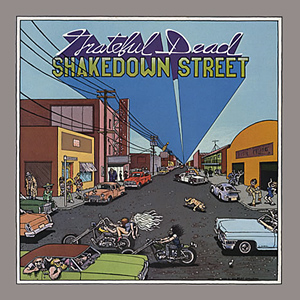As a band that is renowned for its live performances, the Grateful Dead’s studio albums tend to be unfairly overlooked. Nov. 15, 2023 marks the 45th anniversary of one of their most eclectic works: 1978’s “Shakedown Street.” The album is filled with disco and funk influences that showed the band could branch out from their established style.
“Shakedown Street” is a direct result of the pop music climate of the time. In 1978, disco reigned as the top genre, with the Bee Gees claiming three of the top six songs on Billboard’s end-of-year chart. For a band that adapted its sound countless times across the three decades between its first and last studio release, it is no surprise to see an attempt to play into the trends of the time.
Their previous album, “Terrapin Station” had a slight disco influence, specifically the song “Dancin’ in the Streets,” though it was not embraced to nearly the same extent. While many critics at the time did not appreciate this release by what they referred to as the “Disco Dead,” there is much to appreciate here. For better or worse, it is always interesting to see a band take their sound in a completely new direction. Remaining stagnant was simply not the Dead’s nature, and the variation between this album and their other works shows the creative risk taking and adaptability that made their iconic live shows so captivating.
While not many songs off this album would become staples at these performances, one notable exception is “Fire on the Mountain.” This track originated as an instrumental written by Mickey Hart; after adding lyrics from the renowned songwriting tandem of Jerry Garcia and Robert Hunter, it became the song that exists today. While the studio version is just under four minutes, audiences were treated to renditions often stretching more than fifteen minutes countless times after its live debut in 1977. The debut appearance was at a Winterland set in San Francisco the year before the album’s release, the number being repeated over decades of touring.
The Dead were known for their ability to seamlessly transition from song to song during their performances, and over time “Fire on the Mountain” would become synonymous with “Scarlet Begonias.” The combination, commonly referred to as “ScarFire,” would be repeated countless times over their touring career, to the point where fans were surprised if they heard one without the other. Additionally, “Good Lovin’” and the album’s title track would both make frequent appearances on the band’s setlists in the following decades as high-energy, danceable numbers.
The term “Shakedown Street” would soon come to represent far more than that to fans of the band. While the world-famous jamming that happened on stage at Dead shows was always the main attraction, the sideshow occurring outside the stadium was often just as unique. By the early 1980’s, the band had been touring for nearly two decades and had amassed a notoriously loyal following. These fans, known as “Deadheads,” were known to follow the group across the entire country, through numerous cities and venues. As such, a large percentage of the attendees of any given show had nowhere to stay in the area and needed to get creative. It became commonplace for fans to set up camp in the parking lot outside of a venue for the duration of the Dead’s run there. By night, people would retire to their vans, tents or any number of alternatives to sleep, and as the day came the lots would become a free-for-all.
These temporary residences would form a makeshift community that permanently became known as “Shakedown Street.” The population of the lots would swell on the day of the concerts, as many fans would park their car just for the day and join in on the experience.
In preparation for the upcoming show, vendors would set up stands or simply wander through the crowd to sell their goods. Tickets, apparel, drugs or anything else that might appeal to the diverse population could be found with ease. Oftentimes, these merchants weren’t even looking to make a profit. It was not uncommon for items to be sold at the exact cost they were purchased for, as the seller simply wanted others to experience the joy of owning a souvenir.
This tradition, as well as the sense of community, can still be found today. Dead and Company is a tribute band featuring multiple original members. A thriving Shakedown Street lot can be found outside of many of their shows, over 50 years after those members started touring.
The influence can be seen surrounding jam bands that have no relation to the original, as the parking lot outside of any current jam band’s concert is likely to share many aspects with those of the Dead’s early ‘80’s concerts. The lot scene of today’s most popular jam band, Phish, is called Shakedown Street despite having no connection to the band other than a similar fanbase.
45 years ago, the Grateful Dead took a stylistic risk with their tenth studio album, and while reactions to this have always been mixed, it is undeniable that the project left a lasting impact on the band and the culture of live music for decades to come.
JD Hildreth can be reached at [email protected].



















